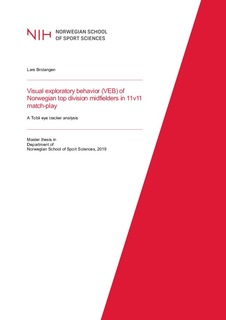| dc.description.abstract | The main aim of this study was to learn more about the way elite midfield football players use their eyes during head turns in 11v11 match-play, including how performance is affected by visual exploratory behaviour, how contextual factors affect the visual exploratory behaviour of elite midfield players, the role of fixations, timing of head turn initiation, and the duration of head turns. A field- and observational study was conducted and Gibson’s (1979) ecological approach to visual perception applied as a theoretical framework together with the vision-inaction paradigm (Vickers, 1992, 2007, 2009). Four male elite midfield players (M = 20,75 years, SD = 2,87) from the Norwegian top division (Eliteserien) was investigated in 11v11 match-play situations using a mobile eye tracking device as well as an overview video film of the match-play. The content of the participants head turns was registered using the Tobii Pro Glasses 2 (Tobii Technology AB, Sweden). The head turns were analysed frame by frame using Tobii Pro Lab Analyzer and Scratch Play.
Results showed that fixations occur in less than one out of five head turns. Further, fixations occur in one out of three long duration head turns. Most head turns were initiated when the ball travelled between players and when a player had control of the ball without touching it. There were more opponents than teammates visible to the players in their head turns stop phase. A tendency of a positive correlation between the number of head turns performed by players in the final ten seconds before receiving the ball and performance was found, however not statistically significant. In attack most head turns were performed when the ball was within close proximity to the player. A relationship between the distance from the analysed player to the ball and head turn duration was found, as when in close proximity to the ball almost half of all head turns were of short duration.
This study was the first research conducted on 11v11 match-play using a mobile eye tracker, making it an exploratory study. The results indicate that the peripheral vision play an important role in elite midfielders’ visual exploratory behaviour and that head turn frequency affect performance positively. The results provided need more research before conclusions can be drawn. Hopefully, the study can generate hypotheses for future research and function as a guide in future research using eye tracking technology to investigate visual perception in football. | nb_NO |
